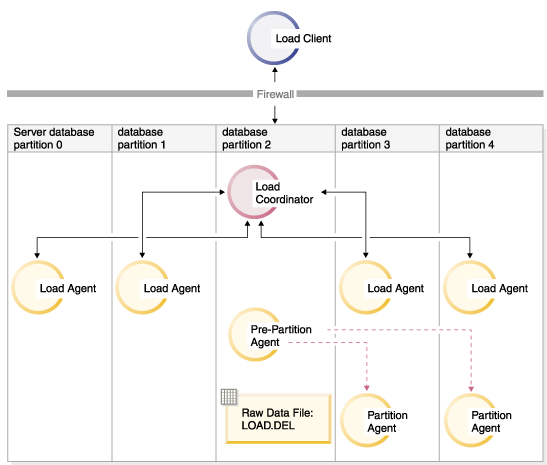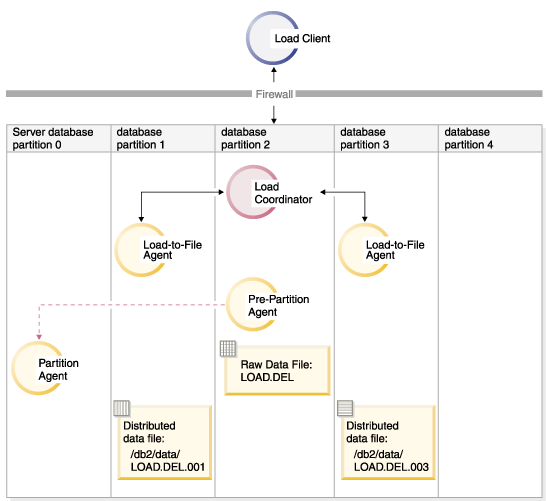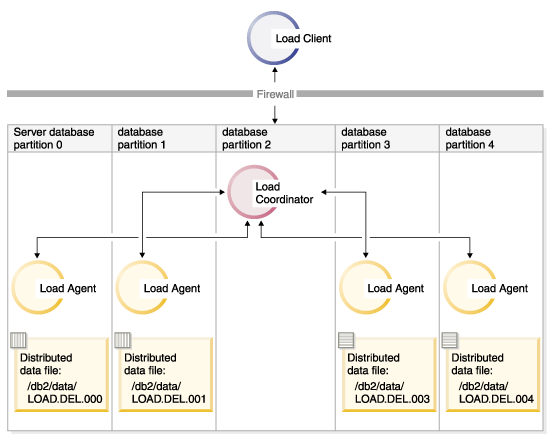Using the load utility to load data into a partitioned
database environment.
About this task
The following restrictions apply when using the load utility
to load data in a multi-partition database:
- The location of the input files to the load operation cannot be
a tape device.
- The ROWCOUNT parameter is not supported unless
the ANALYZE mode is being used.
- If the target table has an identity column that is needed for
distributing and the identityoverride file type
modifier is not specified, or if you are using multiple database partitions
to distribute and then load the data, the use of a SAVECOUNT greater
than 0 on the LOAD command is
not supported.
- If an identity column forms part of the distribution key, only
the PARTITION_AND_LOAD mode is supported.
- The LOAD_ONLY and LOAD_ONLY_VERIFY_PART modes
cannot be used with the CLIENT parameter of the LOAD command.
- The LOAD_ONLY_VERIFY_PART mode cannot be used
with the CURSOR input source type.
- The distribution error isolation modes LOAD_ERRS_ONLY and
SETUP_AND_LOAD_ERRS cannot be used with the ALLOW
READ ACCESS and COPY YES options of
the LOAD command.
- Multiple load operations can load data into the same
table concurrently if the database partitions specified by theOUTPUT_DBPARTNUMS and PARTITIONING_DBPARTNUMS options
do not overlap. For example, if a table is defined on database partitions
0 through 3, one load operation can load data into database partitions
0 and 1 while a second load operation can load data into database
partitions 2 and 3. If the database partitions specified by the PARTITIONING_DBPARTNUMS options
do overlap, then load will automatically choose a PARTITIONING_DBPARTNUMS parameter
where no load partitioning subagent is already executing on the table,
or fail if none are available.
Starting with Version
9.7 Fix
Pack 6, if the database partitions specified by the PARTITIONING_DBPARTNUMS options
do overlap, the load utility automatically tries to pick up a PARTITIONING_DBPARTNUMS parameter
from the database partitions indicated by OUTPUT_DBPARTNUMS where
no load partitioning subagent is already executing on the table, or
fail if none are available.
It is strongly recommended that
if you are going to explicitly specify partitions with the PARTITIONING_DBPARTNUMS option,
you should use that option with all concurrent LOAD commands,
with each command specifying different partitions. If you only specify PARTITIONING_DBPARTNUMS on
some of the concurrent load commands or if you specify overlapping
partitions, the LOAD command will need to pick
alternate partitioning nodes for at least some of the concurrent loads,
and in rare cases the command might fail (SQL2038N).
- Only Non-delimited ASCII (ASC) and Delimited ASCII (DEL) files
can be distributed across tables spanning multiple database partitions.
PC/IXF files cannot be distributed, however, you can load a PC/IXF
file into a table that is distributed over multiple database partitions
by using the load operation in the LOAD_ONLY_VERIFY_PART mode.
Example
The
following examples illustrate how to use the LOAD command
to initiate various types of load operations. The database used in
the following examples has five database partitions: 0, 1, 2, 3 and
4. Each database partition has a local directory /db2/data/.
Two tables, TABLE1 and TABLE2, are defined on database partitions
0, 1, 3 and 4. When loading from a client, the user has access to
a remote client that is not one of the database partitions.
Loading
from a server partition
Distribute and load example
In
this scenario, you are connected to a database partition that might
or might not be a database partition where TABLE1 is defined. The
data file
load.del resides in the current working
directory of this database partition. To load the data from
load.del
into all of the database partitions where TABLE1 is defined, issue
the following command:
LOAD FROM LOAD.DEL of DEL REPLACE INTO TABLE1
Note: In
this example, default values are used for all of the configuration
parameters for partitioned database environments: The MODE parameter
defaults to PARTITION_AND_LOAD, the OUTPUT_DBPARTNUMS parameter
defaults to all database partitions on which TABLE1 is defined, and
the PARTITIONING_DBPARTNUMS defaults to the set
of database partitions selected according to the LOAD command
rules for choosing database partitions when none are specified.
To
perform a load operation where data is distributed over database partitions
3 and 4, issue the following command:
LOAD FROM LOAD.DEL of DEL REPLACE INTO TABLE1
PARTITIONED DB CONFIG PARTITIONING_DBPARTNUMS (3,4)
Figure 1. Loading data into database partitions 3 and 4..
This
diagram illustrates the behavior resulting when the previous command
is issued. Data is loaded into database partitions 3 and 4.
Distribute only example
In this scenario, you
are connected to a database partition that might or might not be a
database partition where TABLE1 is defined. The data file
load.del resides
in the current working directory of this database partition. To distribute
(but not load)
load.del to all the database partitions
on which TABLE1 is defined, using database partitions 3 and 4 issue
the following command:
LOAD FROM LOAD.DEL of DEL REPLACE INTO TABLE1
PARTITIONED DB CONFIG MODE PARTITION_ONLY
PART_FILE_LOCATION /db2/data
PARTITIONING_DBPARTNUMS (3,4)
This
results in a file
load.del.xxx being
stored in the
/db2/data directory on each database
partition, where
xxx is a three-digit representation
of the database partition number.
To distribute the
load.del file
to database partitions 1 and 3, using only one partitioning agent
running on database partition 0 (which is the default for
PARTITIONING_DBPARTNUMS),
issue the following command:
LOAD FROM LOAD.DEL OF DEL REPLACE INTO TABLE1
PARTITIONED DB CONFIG MODE PARTITION_ONLY
PART_FILE_LOCATION /db2/data
OUTPUT_DBPARTNUMS (1,3)
Figure 2. Loading data into database partitions 1 and 3 using one partitioning
agent..
This diagram illustrates the behavior that results
when the previous command is issued. Data is loaded into database
partitions 1 and 3, using one partitioning agent running on database
partition 0.
Load only example
If you have already performed
a load operation in the
PARTITION_ONLY mode and
want to load the partitioned files in the
/db2/data directory
of each loading database partition to all the database partitions
on which TABLE1 is defined, issue the following command:
LOAD FROM LOAD.DEL OF DEL REPLACE INTO TABLE1
PARTITIONED DB CONFIG MODE LOAD_ONLY
PART_FILE_LOCATION /db2/data
Figure 3. Loading data into all database partitions where a specific
table is defined..
This diagram illustrates the behavior
resulting when the previous command is issued. Distributed data is
loaded to all database partitions where TABLE1 is defined.
To load into database partition 4 only, issue the following
command:
LOAD FROM LOAD.DEL OF DEL REPLACE INTO TABLE1
PARTITIONED DB CONFIG MODE LOAD_ONLY
PART_FILE_LOCATION /db2/data
OUTPUT_DBPARTNUMS (4)
Loading
pre-distributed files without distribution map headers
The
LOAD command
can be used to load data files without distribution headers directly
into several database partitions. If the data files exist in the
/db2/data directory
on each database partition where TABLE1 is defined and have the name
load.del.xxx,
where
xxx is the database partition number, the
files can be loaded by issuing the following command:
LOAD FROM LOAD.DEL OF DEL modified by dumpfile=rejected.rows
REPLACE INTO TABLE1
PARTITIONED DB CONFIG MODE LOAD_ONLY_VERIFY_PART
PART_FILE_LOCATION /db2/data
To
load the data into database partition 1 only, issue the following
command:
LOAD FROM LOAD.DEL OF DEL modified by dumpfile=rejected.rows
REPLACE INTO TABLE1
PARTITIONED DB CONFIG MODE LOAD_ONLY_VERIFY_PART
PART_FILE_LOCATION /db2/data
OUTPUT_DBPARTNUMS (1)
Note: Rows
that do not belong on the database partition from which they were
loaded are rejected and put into the dumpfile, if one has been specified.
Loading
from a remote client to a multi-partition database
To load
data into a multi-partition database from a file that is on a remote
client, you must specify the
CLIENT parameter
for the
LOAD command. This parameter indicates
that the data file is not on a server partition. For example:
LOAD CLIENT FROM LOAD.DEL OF DEL REPLACE INTO TABLE1
Note: You
cannot use the LOAD_ONLY or LOAD_ONLY_VERIFY_PART modes
with the CLIENT parameter.
Loading
from a cursor
As in a single-partition database, you can
load from a cursor into a multi-partition database. In this example,
for the PARTITION_ONLY and LOAD_ONLY modes,
the PART_FILE_LOCATION parameter must specify
a fully qualified file name. This name is the fully qualified base
file name of the distributed files that are created or loaded on
each output database partition. Multiple files can be created with
the specified base name if there are LOB columns in the target table.
To
distribute all the rows in the answer set of the statement
SELECT
* FROM TABLE1 to a file on each database partition named
/db2/data/select.out.xxx
(where
xxx is the database partition number), for
future loading into TABLE2, issue the following commands:
DECLARE C1 CURSOR FOR SELECT * FROM TABLE1
LOAD FROM C1 OF CURSOR REPLACE INTO TABLE2
PARTITIONED DB CONFIG MODE PARTITION_ONLY
PART_FILE_LOCATION /db2/data/select.out
The
data files produced by the previous operation can then be loaded by
issuing the following
LOAD command:
LOAD FROM C1 OF CURSOR REPLACE INTO TABLE2
PARTITIONED CB CONFIG MODE LOAD_ONLY
PART_FILE_LOCATION /db2/data/select.out


